In our research we measure behavior, brain responses, and visual fixations.
Behavior
 In adults, I use a variety of behavioral measures including reaction time responses and accuracy. Reaction time is the period of time elapsed between the presentation of a stimulus and a behavioral response (typically a button press). Accuracy is a measure of the number of correct responses. We also break apart or combine these measures in interesting ways to better understand learning. To measure behavior in infants we often videotape looking responses or interactions with parents or objects and then code these videos for specific behaviors, like the number of times or total amount of time looking at faces or objects. Infants tend to look longer toward new and interesting things so we can capitalize on this preference to better understand infant cognition and perception.
In adults, I use a variety of behavioral measures including reaction time responses and accuracy. Reaction time is the period of time elapsed between the presentation of a stimulus and a behavioral response (typically a button press). Accuracy is a measure of the number of correct responses. We also break apart or combine these measures in interesting ways to better understand learning. To measure behavior in infants we often videotape looking responses or interactions with parents or objects and then code these videos for specific behaviors, like the number of times or total amount of time looking at faces or objects. Infants tend to look longer toward new and interesting things so we can capitalize on this preference to better understand infant cognition and perception.
Brain Responses
 Our lab also records Event-related Potentials (ERPs) from both adults and infants using a variety of tasks. Recordings of ERPs have proven to be a useful tool for understanding infant perceptual development and can be recorded non-invasively from a net of recording electrodes placed on the head. ERPs reflect the activity of simultaneously active populations of neurons in the cerebral cortex. This neuronal activity results in electrical signals that can be recorded by the electrodes. By time-locking these brain responses to the presentation of images or sounds, we can learn more about how the brain responds before, after, or during learning. The advantage of using ERPs with developmental populations is that no verbal or motor response is required, and ERPs provide very good information about when perception or learning is happening in the brain.
Our lab also records Event-related Potentials (ERPs) from both adults and infants using a variety of tasks. Recordings of ERPs have proven to be a useful tool for understanding infant perceptual development and can be recorded non-invasively from a net of recording electrodes placed on the head. ERPs reflect the activity of simultaneously active populations of neurons in the cerebral cortex. This neuronal activity results in electrical signals that can be recorded by the electrodes. By time-locking these brain responses to the presentation of images or sounds, we can learn more about how the brain responds before, after, or during learning. The advantage of using ERPs with developmental populations is that no verbal or motor response is required, and ERPs provide very good information about when perception or learning is happening in the brain.
Eye-tracking
![]() The BCD lab uses eye-tracking technology to accurately measure infant and adult looking behaviors. Measuring eye fixations and movements allows us to better understand learning and strategy use. We can examine where on a face infants look during language learning or how long they look at a very familiar object versus a novel object they have never seen before. In adults we can measure how long and how quickly they look at the parts of an image that are the most important for recognition and identification and whether or not this changes with learning and expertise.
The BCD lab uses eye-tracking technology to accurately measure infant and adult looking behaviors. Measuring eye fixations and movements allows us to better understand learning and strategy use. We can examine where on a face infants look during language learning or how long they look at a very familiar object versus a novel object they have never seen before. In adults we can measure how long and how quickly they look at the parts of an image that are the most important for recognition and identification and whether or not this changes with learning and expertise.